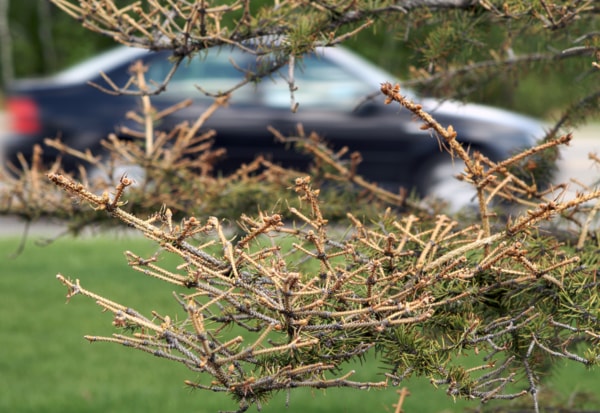Yet another tree pest has reared its larval head to plague gardeners and parks workers in Red Deer.
The yellowheaded spruce sawfly is making its pesky presence known — especially in the northeastern parts of the city, where Elaine Johnson has spotted “endangered” boulevard trees with damaged branch ends.
Johnson, the City of Red Deer’s arborist and urban gardener, advises home and business owners to take a good look at their young Englemann, white, black or blue spruce trees for signs of missing needles.
The Yellowheaded Spruce Sawfly is a native species that’s been present in Red Deer for several years, but this year, its population is burgeoning.
The pest typically picks on younger spruce trees that are less than three or four metres high, said Johnson, who has noticed damaged trees with brownish, shrivelled branch ends and stripped needles around the parking lots of many private businesses on the city’s northeast.
She and other parks workers have been dealing with the same blight on city boulevard trees. “It’s stressed trees that are particularly vulnerable.”
Johnson noted boulevard trees or those used on berms or landscaped lawns are most susceptible to the sawfly because they aren’t in a natural setting, have been exposed to drought — with very dry autumns over the last three years, and regularly put up with traffic pollution and road salt.
“I’ve noticed a lot of (infested trees) in commercial areas because, unlike with homeowners, nobody’s there looking out for damage.”
An adult yellowheaded spruce sawfly will lay eggs under a young spruce. When the olive green, striped caterpillars with yellowish-brown heads emerge, they begin eating the tree’s needles, starting with new growth and proceeding to older foliage.
Damage will appear only on certain sections of a spruce. But Johnson said if the pests are left untreated, growth will be stunted, and the tree will eventually die.
City workers use insecticidal soap to get rid of larvae. But Johnson said chemicals should only be used if property owners are sure there’s an infestation and it’s spread beyond just a few branches.
Otherwise, “if you’re not too squeamish,” Johnson said the caterpillars can be picked off and disposed of in sealed garbage bags, or the affected tree branches can also be pruned, and again, disposed of.
A high-pressure water spray can blast the larvae off (although adult sawflies can crawl back up the trees if present).
Johnson said it’s important to get rid of the pests to stop them from spreading to other properties and to preserve spruce trees. City parks workers are also still combatting the bronze leaf disease fungus this spring. It invades several species of poplars and hybrids, most notably the Swedish columnar aspen and tower poplar.
The disease turns the tree leaves red-brown or bronze by mid-summer. The shrivelled leaves do not fall off in the autumn, but stay on the tree all winter.
Pruning is the only way to get rid of the fungus, said Johnson, who added the affected branches should be trimmed about a foot below visible signs of infection. The pruned bits need to go to the landfill in sealed bags — not into a chipper or fireplace.
Johnson said airborne fungus spores spread quickly from tree to tree, so immediate action is needed.
For more information, please call 403-342-8344.
lmichelin@www.reddeeradvocate.com
